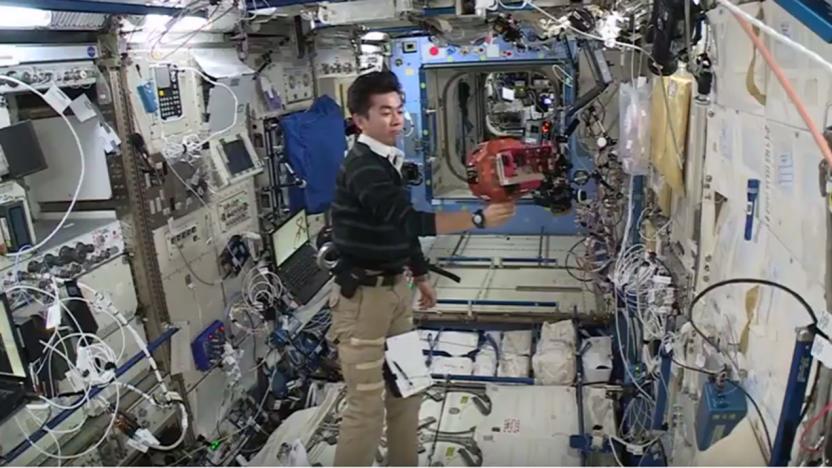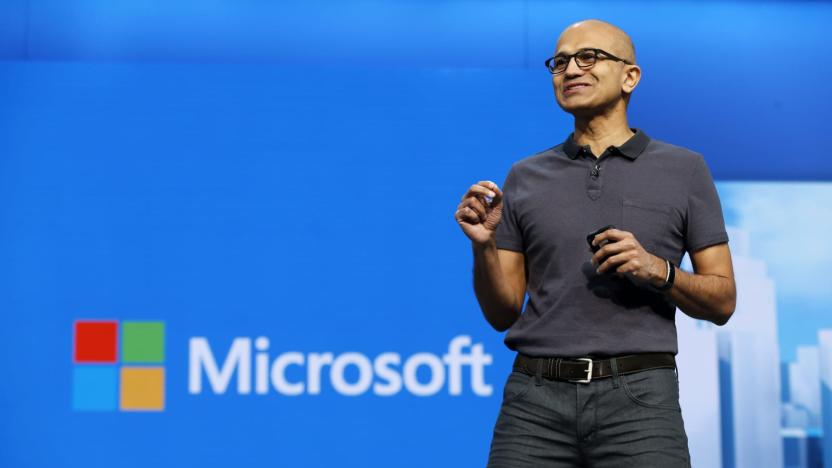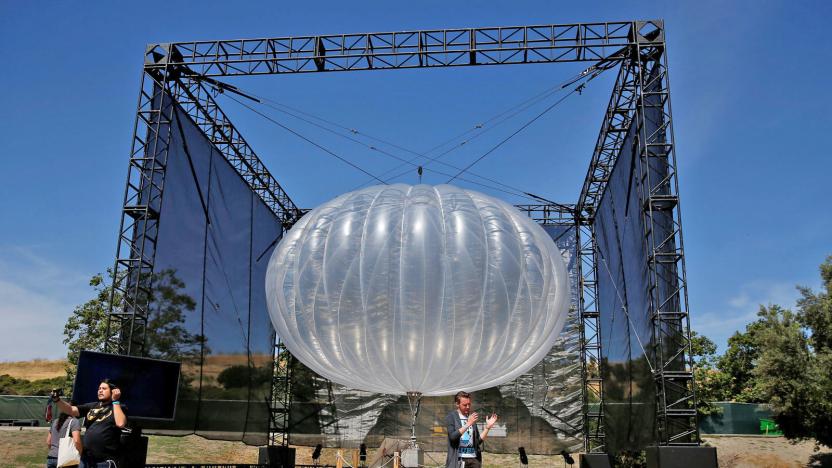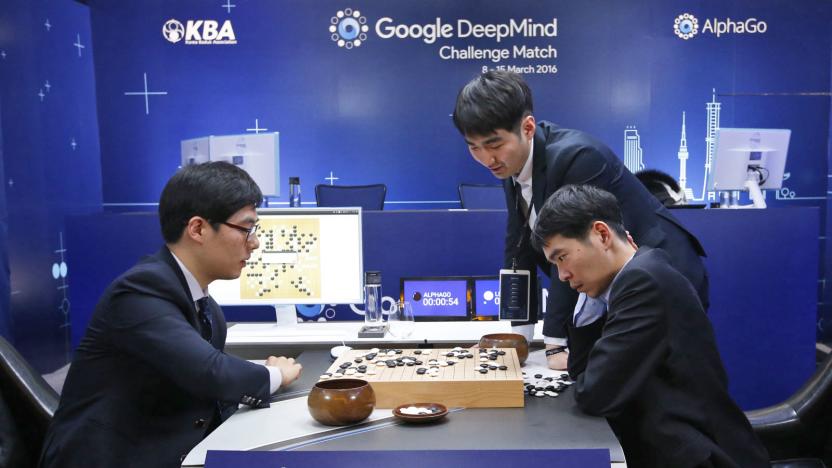MachineLearning
Latest

Google releases massive visual databases for machine learning
It seems like we hear about a new breakthrough using machine learning nearly every day, but it's not easy. In order to fine-tune algorithms that recognize and predict patterns in data, you need to feed them massive amounts of already-tagged information to test and learn from. For researchers, that's where two recently-released archives from Google will come in. Joining other high-quality datasets, Open Images and YouTube8-M provide millions of annotated links for researchers to train their processes on.

Space drone learns how to see with one eye in zero-G
One of the small drones aboard the ISS taught itself how to go around station with just one eye, and it was a lot harder than you might think. For starters, the SPHERE drone (that's short for Synchronized Position Hold Engage and Reorient Experimental Satellite) learned on its own by using machine learning. That method isn't typically used for space applications, because if it fails, it could result in a costly catastrophe. This is the first time a drone in space employed the technique to teach itself. Robots also still can't judge distances between objects using just one camera. Plus, the drone was operating in microgravity, floating around in a place where there's no up or down.

Yahoo open-sources machine learning porn filter
Yahoo is the latest tech company to open source its computer vision code. The beleaguered outfit's application for it? Filtering porn. Yahoo hopes that its convolutional neural net (CNN) will empower others to better guard innocent eyes, but admits that because of the tech's very nature (and how the definition of "porn" can vary wildly), that the CNN isn't perfect. "This model is a general purpose reference model, which can be used for the preliminary filtering of pornographic images," a post on the Yahoo Engineering Tumblr says. "We do not provide guarantees of accuracy of output, rather, we make this available for developers to explore and enhance as an open source project." The code is available on Github at the moment, and if you need any testing material, well, there isn't exactly a shortage of it on Tumblr. Just ask Indonesia.

Google opens up its machine learning tricks to all
There may now be an easier way to implement advanced machine learning models in your projects. Google has opened up its Cloud Machine Learning to all businesses in a public beta, after a few months of testing it in private alpha. The tool makes it easier to train models at a much faster rate, and is integrated with the Google Cloud Platform. This has applications for businesses in areas such as customer support (learning how to automate responses to a variety of queries and complaints) or any kind of repetition-heavy task.

Microsoft reorganizes to create a dedicated AI division
Microsoft has reorganized several disparate projects and programs into an entirely new Artificial Intelligence group. It will be the fourth major division after Windows, Office and cloud, reallocating over 5,000 computer scientists and engineers under its umbrella. The shift shows how much unified effort the tech giant believes the field needs, as well as internally standardized AI tech they can more easily integrate into customer products.

Google internet balloon uses AI to stay in place for weeks
When Google first introduced Project Loon, its internet balloons used static algorithms to change altitude and stay in position. While clever, they were limited -- Google couldn't do much to adapt to unexpected weather patterns, which are quite common tens of thousands of feet in the air. Flash forward to today, however, and it's a different story. The Project Loon team has revealed that it's using artificial intelligence technology (specifically, machine learning) to alter balloons' behavior and keep them in position for much longer. One test balloon stayed in the Peruvian stratosphere for 98 days, adapting to tricky wind conditions that might have sent it drifting away.

IBM and MIT team up to help AI see and hear like humans
Autonomous robots and other AI systems still don't do a great job of understanding the world around them, but IBM and MIT think they can do better. They've begun a "multi-year" partnership that aims to improve AI's ability to interpret sight and sound as well as humans. IBM will supply the expertise and technology from its Watson cognitive computing platform, while MIT will conduct research. It's still very early, but the two already have a sense of what they can accomplish.

Microsoft hopes AI will find better cancer treatments
Google isn't the only tech giant hoping that artificial intelligence can aid the fight against cancer. Microsoft has unveiled Project Hanover, an effort to use AI for both understanding and treating cancers. To begin with, the company is developing a system that would automatically process legions of biomedical papers, creating "genome-scale" databases that could predict which drug cocktails would be the most effective against a given cancer type. An ideal treatment wouldn't go unnoticed by doctors already swamped with work.

SwiftKey for Android is now powered by a neural network
From today, the popular keyboard app SwiftKey will be powered by a neural network. The latest version of the app combines the features of its Neural Alpha, released last October, and its regular app in order to serve better predictions. It's the first major change to the main SwiftKey app since Microsoft acquired the London-based company earlier this year. Understanding why the new SwiftKey is going to be better than what came before it requires a little effort, but the real-world benefits are definitely tangible. See, the regular SwiftKey app has, since its inception, used a probability-based language algorithm based on the "n-gram" model for predictions. At its core, the system read the last two words you've written, checked them against a large database and picked three words it thought might come next, in order of probability. That two-word constraint is a serious problem for predicting what a user is trying to say. If I were to ask you to guess the word that comes after the fragment "It might take a," the first suggestion you come up with is unlikely to be "look." But with a two-word prediction engine, it's only looking at "take a," and "look" is the first suggestion. There had to be a better solution. Simply upping the number of words it looks at is impractical -- the database grows exponentially with every word you add -- so SwiftKey's initial solution was to boost its n-gram engine with less fallible, personalized data. If you regularly use phrases, SwiftKey uses that data to improve predictions. And you could also link social media and Gmail accounts for better predictions.

Neural networks are powerful thanks to physics, not math
When you think about how a neural network can beat a Go champion or otherwise accomplish tasks that would be impractical for most computers, it's tempting to attribute the success to math. Surely it's those algorithms that help them solve certain problems so quickly, right? Not so fast. Researchers from Harvard and MIT have determined that the nature of physics gives neural networks their edge.

Intel buys Movidius to build the future of computer vision
Intel is making it extra-clear that computer vision hardware will play a big role in its beyond-the-PC strategy. The computing behemoth has just acquired Movidius, a specialist in AI and computer vision processors. The Intel team isn't shy about its goals. It sees Movidius as a way to get high-speed, low-power chips that can power RealSense cameras in devices that need to see and understand the world around them. Movidius has already provided the brains behind gadgets like drones and thermal cameras, many of which are a logical fit for Intel's depth-sensing tech -- and its deals with Google and Lenovo give nothing to sneeze at, either.

Google AI builds a better cucumber farm
Artificial intelligence technology doesn't just have to solve grand challenges. Sometimes, it can tackle decidedly everyday problems -- like, say, improving a cucumber farm. Makoto Koike has built a cucumber sorter that uses Google's TensorFlow machine learning technology to save his farmer parents a lot of work. The system uses a camera-equipped Raspberry Pi 3 to snap photos of the veggies and send the shots to a small TensorFlow neural network, where they're identified as cucumbers. After that, it sends images to a larger network on a Linux server to classify the cucumbers by attributes like color, shape and size. An Arduino Micro uses that info to control the actual sorting, while a Windows PC trains the neural network with images.

The Power Egg is unlike any drone you've ever flown before
try{document.getElementById("aol-cms-player-1").style.display="none";}catch(e){}Normally, when you think "quadcopter", you think of the standard block-shaped mass of propellers, struts and landing gear. But nothing says they have to look that way. In fact, one drone company from China is taking a radically different approach with a UAV that looks like something from the labs of Capsule Corp.

Prisma's arty photo filters now work offline
There's a lot going on behind the curtain with Prisma, the app that turns your banal photos into Lichtenstein- or Van Gogh-esque artworks. The app actually sends your cat photo to its servers where a neural network does the complex transformation. Starting soon, that will no longer be necessary, though. "We have managed to implement neural networks to smartphones, which means users will no longer need an internet connection to turn their photos into art pieces," the company says. Only half of Prisma's styles will be available offline at first (16 total), but others will be added in the "near future."

How a robot wrote for Engadget
John McCarthy, the late computer scientist who first coined the term "artificial intelligence," famously said: "As soon as it works, no one calls it AI any more." What was once cutting-edge AI is now considered standard behavior for computers. As I write this, my computer is continuously performing millions of tasks, caching files, managing RAM and balancing CPU loads. The algorithms behind many of these operations would have been considered AI years ago. Now it's just software. Last year, I looked into how well neural networks -- programs that behave like a scaled-down version of your brain's neurons -- are able to write. My plan was to create a bot that could write articles for Engadget. As I discovered, we're not yet at the point in which such applications can think and write like humans, but they can do a reasonable job of writing readable sentences. As I noted at the time, some companies are using less "advanced" methods to produce content automatically. One such company is Automated Insights, whose tools are used by a number of companies to autogenerate reports, and also by the Associated Press to write articles about sports and finance. I've been using one of Automated Insights' products, Wordsmith, trying again to make a computer write like Engadget. It's easy to argue that Wordsmith isn't AI. It doesn't use machine learning and neural networks, but it does work. And thanks to that fact, I've been much more successful in my mission to automate the art of the tech blog.

Microsoft figured out how cloud servers can swap encrypted data
A team at Microsoft Research has figured out a way to share encrypted information stored in the cloud without compromising security. The example the outfit gives is as follows:

Apple buys a Seattle-based AI startup for $200 million
Apple has snapped up a Seattle-based startup called Turi that specializes in machine learning, likely in an effort to boost its products' AI capabilities. Ever the secretive corporation, Cupertino hasn't released details about the acquisition besides confirming it to Recode and other publications. A spokesperson merely answered all questions with this statement: "Apple buys smaller technology companies from time to time, and we generally do not discuss our purpose or plans." According to GeekWire, though, the company bought the startup for around $200 million.

Prisma's neural net-powered photo app arrives on Android
When Prisma Labs said you wouldn't have to wait long to use its Android app outside of the beta test, it wasn't joking around. The finished Prisma app is now readily available on Google Play, giving anyone a chance to see what iOS users were excited about a month ago. Again, the big deal is the use of cloud-based machine learning to turn humdrum photos into hyper-stylized pieces of art -- vivid brush strokes and pencil lines appear out of nowhere. Give it a shot if you don't think your smartphone's usual photo filters are enough.

Try Prisma's machine-learned art filters on Android (updated)
The latest heavily-filtered trend in your Instagram feed, Prisma, is now headed to Android on beta. The Russian-made app uses machine learning to severely tweak your images to something that almost approximates art -- and it's addictive, smart and sometimes annoying if you like photos that look like, well, photos. Since launching on iOS a month ago, the app rocketed to the top of the charts in multiple countries, although another certain app has proved even more popular. The beta is available here, but the company says this is just the start: it's also promised video filters and (zeitgeisty) 360-degree panoramas too.

Google buys startup that helps your phone identify objects
Google has purchased Moodstocks, a French startup that specializes in speedy object recognition from a smartphone, showing (again) the search giant's intense interest in AI. Unlike other products (including Google's own Goggles object recognition app) Moodstocks does most of the crunching on your smartphone, rather than on a server. While Google seemingly has some pretty good image-spotting tech already, like the canny visual categorization in Photos, it says it's just getting started.









